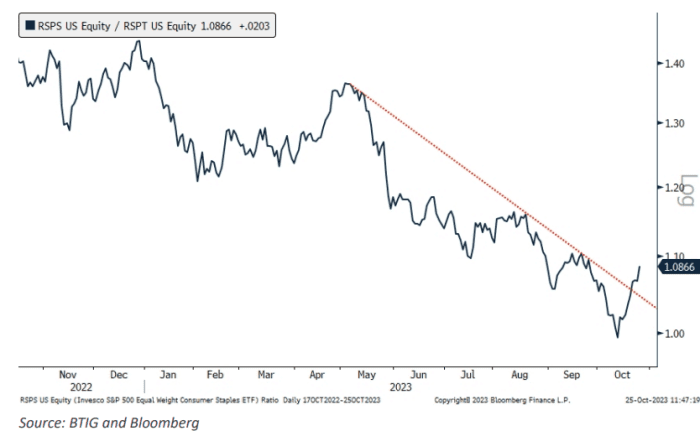This post was originally published on this site
It’s easy to forget the stock-market sectors labeled as “defensive” may sometimes fail to provide shelter to investors.
Stocks in the consumer-staples and utilities sectors have had a tough run so far in 2023 as investors fled low-volatility and dividend-paying shares in favor of higher yields and less risk in the U.S. Treasurys.
The S&P 500 Utilities
XX:SP500.55
and Consumer Staples
XX:SP500.30
are two of the worst-performing sectors of the benchmark index so far this year, down 16% and 7.8%, respectively, compared with 37% and 33.5% of year-to-date advance for the S&P 500 Communication Services
XX:SP500.50
and Information Technology
XX:SP500.45
sector, according to FactSet data.
However, the unusual move for stocks in the traditional defensive sectors could be coming to an end as some stocks are starting to show evidence of breaking the previous downtrends, according to Jonathan Krinsky, managing director and chief market technician at BTIG.
“We continue to think these [stocks] are sufficiently washed out, and should certainly outperform in relative terms with potential upside in absolute terms over the coming months,” Krinsky said in a Wednesday note.
For example, the Consumer Staples Select Sector SPDR Fund
XLP,
which tracks a market-cap-weighted index of consumer staples stocks selected from the S&P 500, has room to rise toward 71, Krinsky said, indicating a nearly 4.5% advance from Wednesday’s level of 67.94, according to FactSet data.
“Many consumer staples charts are in long-term downtrends, but we think they have been sufficiently ‘de-risked’ and are starting to show evidence of breaking out of small bases or breaking those downtrends,” said Krinsky (see chart below).

SOURCE: BTIG, BLOOMBERG
Consumer staples stocks, like those in the utilities and healthcare sectors, are usually considered defensive investments, or “bond proxy,” because they produce necessities and could help investors minimize the impacts caused by stock-market losses or economic downturns. Companies in the consumer staples sector, such as beverage manufacturer Coca-Cola Company
KO,
and Procter & Gamble
PG,
produce and sell products or services that consumers regularly purchase, regardless of economic conditions.
But the sector got slammed in the past month as the rising yields on U.S. Treasurys made the sector less attractive compared with government-issued bonds and money-market funds. The yield on the 10-year Treasury
BX:TMUBMUSD10Y
was rising 12 basis points, to 4.952% on Wednesday afternoon, after touching 5% for the first time in 16 years earlier this week.
At the other end of the spectrum, Krinsky thinks mega-cap tech is still the “most crowded area of the market,” which makes the $201 billion exchange-traded fund Invesco QQQ tracking the Nasdaq 100 index
NDX
“vulnerable” as the fund is likely to see their 200-day-moving-average (200 DMA) over the coming weeks, he wrote.
The 200 DMA is usually considered a key indicator by stock-market participants for determining overall long-term market trends. In general, if the stock price is constantly trading above the 200 DMA, it is considered to follow an uptrend, otherwise, it is believed to exhibit a downtrend.
“The 352-354 level has acted as support several times since August, and we suspect a break below 352 could now see a swift move lower,” Krinsky said. QQQ
QQQ
finished at 350.32 on Wednesday, according to FactSet data.
Technology stocks were getting hammered on Wednesday following mixed third-quarter earnings results from tech behemoths. The Nasdaq Composite
COMP
ended 2.4% lower, suffering its worst daily decline since February, and the S&P 500
SPX
dropped 1.4% to finish at its lowest level since late May.
Meanwhile, the S&P 500 Consumer Staples and Utilities sectors were the only ones in the green on Wednesday, up 0.3% and 0.5%, respectively, while the tech-heavy S&P 500 Communication Services sector tumbled 5.9%, according to Dow Jones Market Data.

